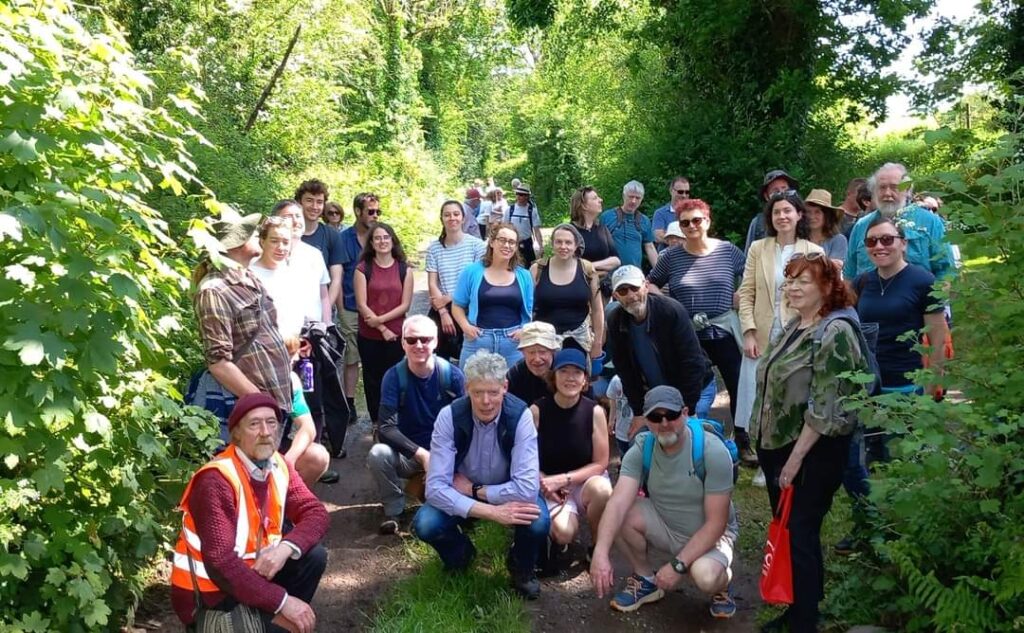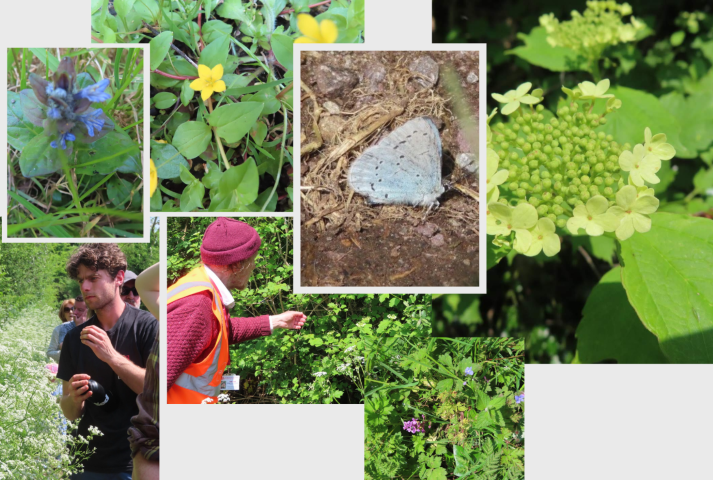Biodiversity Week Event – Sunday May 19th 2024, Annahalla Townland, Kilmichael, Co. Cork

Pic. Credit: Conor Nelligan
Introduction
The Environmental Forum (EF) proposed that we repeat our 2023 Hedgerow walk incorporating a Plant Survey along the same transect (c. 1.6 km).
Our 2023 “Crinniú” was scheduled for Monday May 22nd at 6pm to facilitate the “working week”. This year we opted for the earlier hours of 12pm -4pm as Wild Flowering Plants are best observed when the Sun is high in the sky and the morning dew has passed. Also, the Sun’s energy between 1pm and 3pm draws our butterflies.
“Hedge” derives from very early Anglo-Saxon “Haga” or “Haeg” connoting a boundary. Teagasc, the farm Advisory Service, estimates that c. 670,000 kms of Hedgerow/ Field Boundary have survived into our new century. Research in N. Ireland (1993) estimates 150,000 kms are yest extant in that Province.
Bernie of E.F. suggested each participant learn 5 Plants along our chosen transect, that bounds the Gearagh Nature Refuges southern S.A.C. (Special Area of Conservation/ 1992 Habitats Directive) limits.
Our first (of 41 native species) Butterfly to grace our visitors is the Holly Blue that fluttered welcomingly among our troop. For many, it was their first encounter with Holly Blue, which as it’s name infers, is dependent on our Holly as it’s sole “Food Plant”. It is described as “local where remnants of Native Woodland” yet survive.
Old coppiced Holly and their younger recruits abound along the linear “Under canopy” and in places form the top storey “Canopy” with Grey and Eared Willows, and their hybrids. Our Holly Blue frequently produces a second brood (and rarely a third brood in later Summer) whose “Food Plant” shifts to Ivy. Additional Butterfly species encountered include our Green-veined White (Food Plant – Watercress); Orange Tip (Food Plant – Mayflower/ Lady’s Smock); Speckled Wood (Food Plant – various grasses); Wood White, a species peculiar to Wodland Margins i.e. Hedgerows (Food Plant – Vetchling and Vetch) and Small White (Food Plant – Cabbage Family e.g. Hedge Mustard and Garlic Mustard).
From records, the migrant Painted Lady (from the Atlas Mountains in Morocco) that feeds on our Thistle species, arriving early June, is a regular along our route and adjoining Townland of Inchisine. Linneas named it “Vanessa Cardui” – Carduus being the scientific name of Thistle.
Silver-washed Fritillary, takes to flight in mid-June, being very frequent along our double ranked pathway in the past. We spotted a single violet, our Common Dog Violet – Viola riviniana, – this powerfully gliding and target of our Butterflies Food Plant. Silver-washed Fritillary seeks out sunny patches along Hedgerows.
Following an East-West transect, the Gearagh Wet Woodland to our righthand, the linear oak canopy in full South sunlight to our lefthand has grown such that long stretches are cast in shadow. Author is familiar with this site this past 42 years, having been introduced by our late Jamsie Kearney of Cooleen Townland. Jamsie, still cycling in his late 80s’, described the cutting out of the Gearagh Woodland nearly 30 years earlier (clear fell 1955/57) – 2025 marking this events 70th Anniversary.
In answer to a participant’s question, where did all the vast volume of felled Oak, Yew, Cherry, Holly, Hazel, Buckthorn, Bird Cherry end up? Jamsie, with c. 2 scores others were contracted by the ESB through late 1955 to early -1957, when the Hydro-dams were commissioned. The logs were hauled out by horse traction – the timber being stockpiled at a number of exit ramps constructed for the purpose. We didn’t reach the “Annahalla Slipway” – a stone’s throw from where we picnicked. Horse drawn carts queued up and carted away the logs, freely. One recalls huge stockpiles of timber in the farmyards abutting the Public Walkway from Annahalla that links with the causeway that crosses the Gearagh Floodplain. What were teenage Oaktrees, c.12 inch diameter shoulder height in 1982, are now fine “Maidens”, and what were adults then are now c. a 0.8 metre diameter, along the South rank of our route.
Bernie, spotted Wood Avens, also herb Bennett, originally named “Herba Benedicta” it was believed in Mediaeval Times to protect animals form demons and evil spirits, the trifoliate leaves represented “The Trinity”, the 5 petaled “Royal Yellow” flowers the five wounds of Christ. Also spotted by a keen eye is our shy “Bugle” – blue-violet blossomed of the field storey. Our Yellow Pimpernel (Lus Cholm Cille) attracted well deserved attention, a straggler of the ground storey of Woodland edges i.e. Hedgerows. It’s association with St. Colmcille has been lost to memory, more’s the pity for the ”Ethno-botanist”.

Pic. Credit: Bernie Connolly
Meadowsweet, formerly abundant and continuous along the North rank, in addition to our Willows yields a Salycylic Acid (the pain-killing molecule in Aspirin), in Dunquin we have a record (1965) that its roots produced a black dye. This hermaphrodite plant yields 2 distinct aromas – pungent odours both from its flowers and foliage.
Common Valerian (not the introduced Red Valerian), a deep-toned smalling blossom of damp hedgerows and river banks was observed, poised to flower in June continuously to early August. “Valium” is an extract from this medicinal plant, participants were alerted to it’s potency.
Surprisingly few were familiar with Alder, a keystone plant of river banks and with Ash and Willow gives us the scientific name for “Alluvial Forest” (Alno-Fraxinus-Salicetum). In the 12 months since our 2023 foray, “Ash Dieback” is now pronounced at Annahalla and across the entire Upper Lee Basin. As shared, the loss of Irish Ash spells trouble for it’s many “Obligate” species.
Guelder Rose (Crampbark) we were fortunate to witness the first creamy white flowers of this beautiful native and little known Shrub, abundant both within the Gearagh and connecting Hedgerow corridors. It’s fruit ripen to a “stunning scarlet”. Seal (2008) attests to Guelders remediating Migraines, Muscle Tension and High Blood Pressure.
Wild Angelica, which by mid-July will dominate the field storey (at near 2 metre height) is a stout, hollow stemmed with purple bloom) “Umbel” or “Umbrella” plant of the Carrot Family, with white or pink flowering domes atop the deeply grooved stem. Strongly scented. Also noted from the same family is Cow Parsley – similarly domed.
Hazels take their rightful place along the linear “Under-canopy” some of great age with a new generation finding their feet, prompting our discussion concerning what Trees and Shrubs are “Monoecious” or “Dioecious”. The former bears both Male and Female flowers on the same plant, which in Hazel’s case allows self-fertilisation in isolation. “Dioecious Plants” bear either of the genders e.g. Holly, Rowanberry, Yew, Juniper, Willow, Buckthorn (The Gearagh remains the sole habitat in all Munster with Wildsown Purging Buckthorn) and Aspen.
“Outbreeding” is facilitated by either Wind or Insect Pollination (Anemophilous or Entomophilous respectively) and seems (to Author) the more evolved pathway to disease and pest resistance.
The day brightened up by 3pm in advance of our picnic and although May is a little early for most of our Dragon and Damselflies, we recorded Common Blue Damselfly, Large Red Damselfly and Southern Hawker Dragonfly – the main distinguishing feature being that the Dragon rests with outstretched wings and the Damsels with wings folded together over the body. From June to late August Annahalla is ideal for Dragonfly enthusiasts. Our transect is a stronghold of our most stunning Banded Demoiselle with vivid patches of dark blue – “Splendens” it’s scientific name. Females are easily confused with Beautiful Demoiselle. Both genera play a central role in Eco-systems, policing insect populations.
Our Spindle (peg-wood bush) is abundant across the floodplain – petering out further up or downstream. Come later June our Purple Loosestrife (easily mistaken for Rosebay Willowherb) emerges, a dioecious plant – entomophilous).
Of the 31 native Ferns, we identified Soft Shield; Rusty Male and Male Ferm; Broad Buckler; Lady Fern and Epiphylic Tree Ferns (Polypody) – with Killarney Fern occurring in the Northern portion of this S.A.C.
A question posed – “Why such Plant Diversity on Earth” igniting in listeners a “deep wonder”. The emergence and proliferation of “Life” in Cosmos has not been a “barrel of laughs” through adaptation and “Species Convergence”, we Plants and Animals and Viruses and Bacteria and Fungi and Yeasts represent the “Survivors”.
Our near 4 hour study of this “mingling society” of Native Organisms – this association of “like minded” “Beings” which first emerged c. 350 million years ago is articulated by Native American Herbalist, Christine Quintaskel (1855 -1936):
“Everything on Earth has a purpose, every disease a herb to cure it, and every person a mission”
Author’s favourite description by a Senior Taxonomist (1984) of the Gearagh Eco-System – “Imperfectly Understood” – leaving a space within us to “wonder”.
Ted Cook
Post-Notes
While the bulk of Ireland’s field boundary structures arise from the compulsory provision of the 1667 Cattle Act (Enclosure), our survey route (transect) better corresponds with a linear strip of “Ghost Woodland” as fields were planned, rentier tenants preserved strips of the grubbed out Forest to serve as enclosures.
As described, when assessing the evidence for “Landscape Feature” continuity, it will not be the girth of it’s trees, rather the remnant “Flora Communities” offers our best key criteria. Spindle, Ragged Robin and (July) Great Burnet Saxifrage, Wood anemone etc. alongside Lichen assemblages and some Ferns are widespread along the edges and lanes of Annahalla (Indicator Plants of Ancient Woodland, Cross 2007).
Lichenologist Howard Fox with Author failed to record “Lungwort” Lichen (Lobarion) at Annahalla in 2009. Widespread in Glengarriff’s Oakwoods, this Lichen is intolerant of even low levels of eutrophication, associated with the Intensive Dairying Industry in the vicinity.
Regardless, however, of the contribution to Irelands’ countryside of these “Naturalised structures” “it is the river, and only the river, can provide most of what still remains essential to our Natural Environment”, Milner 1975.
Our Butterflies, being cold-blooded, require 14 – 16 degrees Centigrade to take to the air. Their contribution to “Pollination” can never be quantified under “Natural Capital” Theory. Because they dare not err in distinguishing the correct Food Plant (of the average 600 found in a mature Hedge or Shrubbery) when laying eggs they have mastered “Sound and Smell” (Antennae) and “Taste” (via feet).
All stages, from egg to caterpillar to chrysalis, are vulnerable to Pesticide spraying – windborne drift from remote sources is no less fatal. 2018 Research (Jonathan – Lungren – insects) “for ever 1 pest species, there may be as many as 1,700 non pest insects that become the unintended casualities” of our Chemical Warfare that characterises both (non-Organic) Forestry and Agriculture.
Author alerts readers to the E.U. Directive on Pesticides (2009), transposed into Irish Law in 2012 (155/12). Article 12:- “No person can apply any Pesticide in any area used by the General Public! It is illegal to spray, Chemical Pesticides “where they can drift from treatment area towards sensitive areas – residences, schools, parks, etc.” and new legislation is being drafted by Minister McConalogue that imposes “heavy penalties” (plus loss of single farm payments to farmers) on anyone spraying within 3 metres of any Public Area. Readers that encounter sprayed roadsides or any Public Area such as Churchgrounds, Cemetries, Schools, Carparks, Playing Fields etc., email a photograph plus precise location details to the Department of Agriculture (Pesticide Control Division) promptly. Cite Articles 12 and 15 of Statutory Instrument 155/12 – link to SI.
“If Nature is dead and the Earth is empty – then all violence against Nature is defined as Human Progress”, Dr. Vandana Shiva 2023.
Any readers interested in acquiring the simple skill of Butterfly Recording/ Surveying (run by the National Biodiversity Data Centre) contact Bernie c/o Environmental Forum for Authors details. Assigned transect since 2009 is a 1.5 km stretch of minor road East of Inchigeelagh.
Keep an eye out for field outings in Co. Cork – details shortly appearing on www.heritageweek.ie (August 17th -25th).
Beir Bua – Ted Cook
